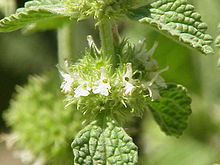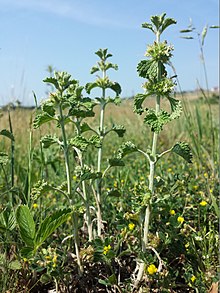Common horehound
| Common horehound | ||||||||||||
|---|---|---|---|---|---|---|---|---|---|---|---|---|

Common horehound ( Marrubium vulgare ) |
||||||||||||
| Systematics | ||||||||||||
|
||||||||||||
| Scientific name | ||||||||||||
| Marrubium vulgare | ||||||||||||
| L. |
The Common horehound ( Marrubium vulgare ), also White Horehound , Horehound , Helfkraut , White Dorant , Marie Nessel or mountain hops called, is a plant of the genus horehound ( Marrubium ) in the family of Labiatae (Lamiaceae). In the past, the species was often cultivated as a medicinal plant. Andorn was named medicinal plant of the year 2018 by scientists from the University of Würzburg .
description
The common horehound is a perennial to semi-shrubby herbaceous plant that reaches heights of 30 to 80 cm. The stems are erect and hairy, especially in the lower part, with white tomentose hair.
The petiole is also shorter than the leaf blade on the lower leaves . The leaves are broadly ovate to circular, the base rounded to almost heart-shaped, the edge deep and serrated irregularly . The leaves are covered with star hair; they are more densely tomentose on the underside than on the balding top. The nerve network is sunk deep into the upper side of the leaf.
The pseudo whorls stand apart and are multi-flowered and spherical. The prophylls are at least as long as the calyx tube, subpulate and shaggy-feathery hairy. The calyx-tube is 3 to 4 mm long, indistinct 10-nerved and shaggy-soft-haired; the calyx teeth, which characterize the species, are usually ten, almost equal, protruding, hooked at the time of fruiting. The crown rises above the calyx by 6 to 7 mm; it is white and has thick star hair on the outside. The Klausen are 1.5 to 2 mm long and have a smooth, gray to light brown surface.
The flowering period extends from May to August.
The number of chromosomes is 2n = 34.
distribution
The common horehound is widespread in the Mediterranean area and has been transported to large parts of North and South America and Australia . In Central Europe, the species is an archaeophyte , which grew wild from the previously widespread medicinal plant cultivation and also became naturalized in warmer regions. Such stable occurrences extend to southern Sweden and southern Scotland . The oldest archaeological evidence in Central Europe comes from the Neolithic Age (4000 BC).
The common horehound occurs in Central Europe mostly in the vicinity of villages and there, as in the Mediterranean area, colonizes ruderal sites and pastures on dry clay and loam soils. In Central Europe it is a character species of the association Onopordion acanthii, but also occurs in the Arction lappae association.
Taxonomy
The scientific name Marrubium vulgare was first published in 1753 by Carl von Linné in Species Plantarum .
Use in medicine
Horehound contains the bitter substance marrubiin, a furanolabdan diterpene as well as essential oils , mucus, resins, waxes and tannins.
Horehound herb is used as a drug ; these are the dried leaves and upper parts of the stem (Marrubii herba). Horehound herb is used in folk medicine as a tea preparation for loss of appetite, digestive problems, biliary problems and bronchial catarrh. In conventional medicine, the drug is less recognized, although as a bitter agent it has been proven to stimulate saliva, gastric juice and bile secretion. An expectorant effect is also reported.
Avril Rodway writes: In a herbal book from 1692 it says: Syrup made from the fresh green leaves of horehound and sugar is an unsurpassable medicine for coughs and whistling . It was also valued as a remedy for worms and poisoning. It is also effective as a laxative.
Due to its outstanding historical significance and the extensive documentation of its effects, the horehound was voted " Medicinal Plant of the Year 2018" by scientists from the University of Würzburg ("Study Group Development History of Medicinal Plant Science ") . The use of the herbaceous plant for catarrh of the respiratory tract, especially bronchitis, as well as digestive problems has been documented for over 2000 years. Today horehound herb is used in Germany to dissolve mucus when coughing in the context of colds. An extract in the form of bronchial drops and fresh plant juices are available as finished medicinal products. Horehound has an expectorant effect on stubborn mucus, anti-inflammatory and antispasmodic.
swell
literature
- J. Cullen: Marrubium L. In: TG Tutin, VH Heywood, NA Burges, DM Moore, DH Valentine, SM Walters, DA Webb (Eds.): Flora Europaea . Volume 3: Diapensiaceae to Myoporaceae . Cambridge University Press, Cambridge 1972, ISBN 0-521-08489-X , pp. 138 (English, limited preview in Google Book search).
- Manfred A. Fischer, Wolfgang Adler, Karl Oswald: Excursion flora for Austria, Liechtenstein and South Tyrol . 2nd, improved and enlarged edition. State of Upper Austria, Biology Center of the Upper Austrian State Museums, Linz 2005, ISBN 3-85474-140-5 .
- Mannfried Pahlow: The Great Book of Medicinal Herbs. Bechtermünz, Augsburg 2002, ISBN 3-8289-1839-5 .
- Eckehart J. Jäger, Klaus Werner (Ed.): Excursion flora from Germany . Founded by Werner Rothmaler. 10th edited edition. tape 4 : Vascular Plants: Critical Volume . Elsevier, Spektrum Akademischer Verlag, Munich / Heidelberg 2005, ISBN 3-8274-1496-2 .
- Jürke Grau, Reinhard Jung, Bertram Münker: Berries, wild vegetables, medicinal herbs (= Steinbach's natural guide ). Mosaik, Munich 1996, ISBN 3-576-10696-0 .
- Hans-Dieter Stoffler: The Hortulus of Walafrid Strabo. From the herb garden of the Reichenau monastery. Thorbecke, Stuttgart 2000, ISBN 3-7995-3506-3 .
- Walter Wurzer: The great encyclopedia of medicinal plants. Your application and your natural healing power. Kaiser, Klagenfurt 1994, ISBN 3-7043-9002-X .
- Ingrid Schönfelder, Peter Schönfelder : The new manual of medicinal plants. Franckh-Kosmos, Stuttgart 2004, ISBN 3-440-09387-5 .
- Karl Hiller, Matthias F. Melzig: Lexicon of medicinal plants and drugs. 2nd Edition. Spektrum Akademischer Verlag, Heidelberg 2010, ISBN 978-3-8274-2053-4 .
- Avril Rodway: Herbs and Spices. The most useful plants in nature - culture and use. Tessloff, Hamburg 1980, ISBN 3-7886-9910-8 .
Individual evidence
- ↑ Marrubium. In: Meyers Großes Konversations-Lexikon. Volume 13, Leipzig 1908, p. 346.
- ↑ a b Medicinal Plant of the Year 2018: Horehound - Marrubium vulgare. World Heritage Monastery Medicine, September 21, 2017.
- ↑ a b c Andreas Kleinsteuber: Lamiaceae, Labiatae . In: Oskar Sebald, Siegmund Seybold, Georg Philippi, Arno Wörz (eds.): The fern and flowering plants of Baden-Württemberg . tape 5 : Special part (Spermatophyta, subclass Asteridae): Buddlejaceae to Caprifoliaceae . Eugen Ulmer, Stuttgart (Hohenheim) 1996, ISBN 3-8001-3342-3 , pp. 153-154 .
- ↑ a b c Gustav Hegi: Illustrated flora of Central Europe. Pteridophyta, Spermatophyta . 2nd Edition. Volume V. Part 4: Angiospermae: Dicotyledones 3 (4) (Labiatae - Solanaceae) . Carl Hanser and Paul Parey, Munich and Berlin / Hamburg 1964, ISBN 3-489-78021-3 , pp. 2393–2399 (unchanged reprint from 1927 with addendum).
- ↑ a b Erich Oberdorfer : Plant-sociological excursion flora . With the collaboration of Theo Müller. 6th, revised and expanded edition. Eugen Ulmer, Stuttgart (Hohenheim) 1990, ISBN 3-8001-3454-3 .
- ↑ Amanda Spooner: Marrubium vulgare. In: Western Australian Herbarium (Ed.): FloraBase. The Western Australian Flora. Department of Environment and Conservation 2007, online.
- ↑ Rafaël Govaerts (ed.): Marrubium vulgare. In: World Checklist of Selected Plant Families (WCSP) - The Board of Trustees of the Royal Botanic Gardens, Kew . Retrieved September 11, 2019.
- ↑ Carl von Linné: Species Plantarum. Volume 2, Lars Salvius, Stockholm 1753, p. 583 ( digitized version ).
- ↑ Committee on Herbal Medicinal Products : Community herbal monograph and assessment report on Marrubium vulgare L., herba. European Medicines Agency (EMA) 604273/2012 (2012)
- ↑ Yousefi, K. et al .: Marrubium vulgare L. methanolic extract inhibits inflammatory response and prevents cardiomyocyte fibrosis in isoproterenol-induced acute myocardial infarction in rats. In: BioImpacts : BI 4.1 (2014)
- ↑ Kanyonga, PM. et al .: Assessment of methanolic extract of Marrubium vulgare for antiinflammatory, analgesic and anti-microbiologic activities. In: J Chem Pharm Res 3 (1): 199-204 (2011)
- ↑ Jorge, VG. et al .: Vasorelaxant effect of ethanolic extracts from M. vulgare: Mexican medicinal plant as potential source for bioactive molecules isolation. In: Indo Global Journal of Pharmaceutical Sciences (2013)
- ^ Schlemper, V. et al .: Antispasmodic effects of hydroalcoolic extract of Marrubium vulgare on isolated tissues. In: Phytomedicine 3 (2): 211-216 (1996)
Web links
- Distribution map for Germany. In: Floraweb .
- Common horehound . In: BiolFlor, the database of biological-ecological characteristics of the flora of Germany.
- Marrubium vulgare L. In: Info Flora , the national data and information center for Swiss flora .
- Distribution in the northern hemisphere from: Eric Hultén, Magnus Fries: Atlas of North European vascular plants. 1986, ISBN 3-87429-263-0 at Den virtuella floran. (swed.)
- Thomas Meyer: Horehound data sheet with identification key and photos at Flora-de: Flora von Deutschland (old name of the website: Flowers in Swabia )
- A wide range of information on Art.
- Gerhard Madaus : Ordinary Horehound in Madaus ( Memento from October 7, 2007 in the Internet Archive )


